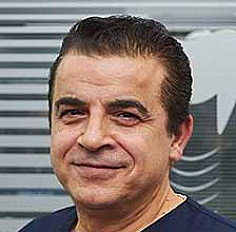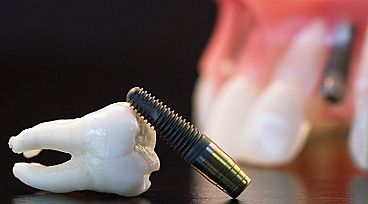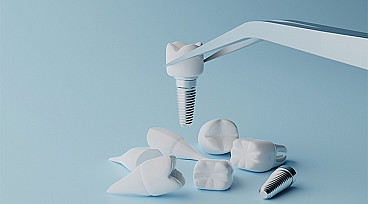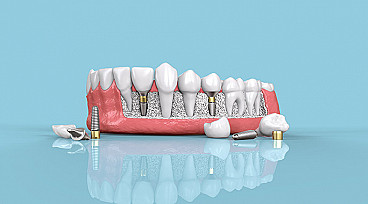Blog
Archive
BASAL IMPLANTS COMPREHENSIVE GUIDE

Date - 2020-08-19 19:11:44
Category - Dental implants
What is Basal Implants
The basis of basal implantology is that it does not take into account the height or width of the available bone as the available cortical (hard) bone with a high degree of mineralization. This bone is not resorbed throughout life, even after tooth extraction.
Between an anchored basal implant in two or three corticals of the bones a mechanical connection is formed, regardless of the biological processes in the bone itself. This allows for immediate loading and the possibility of placing the bridge immediately after implantation.
The conclusion: We can place basal implants in any hard bone where it is, regardless of its size, and load it immediately after insertion of the implant, without waiting for a period of osteointegration or implantation, or requiring additional augmentation with bone replacement materials.
Basal implants allow patients who have never been able to have implants earlier due to their anatomy properties of some vital structures (near the maxillofacial nerve, low maxillary sinuses).
Implanting patients with concomitant diseases such as diabetes, osteoporosis is no longer a contraindication. Implanting Basal implants give them great hopes of high success.
The new design of one-piece basal implants and their smooth surface makes them practically indestructible to inflammation (periimplantitis), due to the inability of bacterial growth on their surface. Thus, they can be safely placed on smokers or patients with periodontal diseases as well as immediately after removal of the tooth.
The first conclusion about Basal implants
removal of the teeth, the osteointegration period , give a great advantage to basal implants.
One of the founders of modern basal implantology is Prof. Dr. Stefan Ihde (Germany). He applied for the first time a new technology for basal immediate implantation, and states that each implant should be anchored in at least two places in the compact bone. This bone has a high level of mineralization and stability and low metabolism and can be instantly loaded. Prof. Dr. Stefan Ihde has perfected a new method for implantation, creating and applying new types of basal implants.
The success of strategic basal implantation requires careful patient preparation and perfect planning of treatment steps as well as knowledge of bone anatomy and physiology to determine the exact locations where basal implants will be anchored.
The second conclusion about Basal implants
When we apply the Immediate Load Implemented Strategic Implant technique, we practically shorten treatment time from 4-5 months to just 5 days and minimize the risks for patients from additional surgical manipulations such as bone augmentation and sinus lifting. This minimizes the pain caused by these operations as well as the unnecessary costs for them.
Immediate implantation with basal implants is a convenient, fast, and safe method. Patients have less post-operative pain, complications, care and less cost. It achieves over 98% success rate.
Basal implants | Long-lasting stable bone connection
The basic implants are anchored in the non-resorbable high quality cortical basal bone. This creates a stable biomechanical connection between the bone and the implant.
Basal implants |Correct distribution of chewing forces with proper and safe chewing of the food
Anchored basal implants distribute biomechanical loads of chewing forces in areas around the compact bone that are highly resistant to resorption and have the highest level of loading.
Basal implants | The distribution of the chewing forces throughout the jaw helps the chewing muscles to function maximally in sync, as well as prevent the risk of atrophy
Strategic implantation results in the distribution of chewing forces away from bone areas around the implant, which are prone to bacterial invasion, and therefore these implants survive very well, even under very unfavorable conditions.
Basal implants | They are suitable for all elderly people without exception
Basal implants can be placed even in the most unfavorable bone situations, regardless of the degree of bone loss:
In the lower jaw - when there is a severe bone deficiency, to avoid the mandibular nerve, they are placed biocortically (in the vestibule-lingual direction).
In the upper jaw, the long basal implants bypass the sinuses by maintaining the bone front and back to the maxillary sinus (tubero-pterygoid implants), thus eliminating the need for bone augmentation and lifting the sinus.
placing basal implants in upper and lower jaw
cheap teeth implants to the patient
In basal implantation, no additional bone substitute is required to increase bone volume (as required by conventional implants bone grafting in maxillary sinus).
Basal implants | A wide variety of cases can be treated that cannot be described with conventional two-part implants
It is due to the variety in shapes, sizes, and specific design of the basal implants.
Basal implants |There is no risk of inflammation around the implant or from dangerous oral infections.
Basic implants have smooth polished surface structures that do not allow bacterial colonization on implant surfaces, which eliminates the occurrence of periimplantitis.
Basal implants | Less errors and fewer risks
Only one surgical procedure with minimal intervention by local anesthesia is required to place basal implants.
Basal implants | Smaller post-operative care and complications (pain and swelling of soft tissues)
The implantation of basal implants can be performed together with extractions of all diseased teeth (deeply fractured, highly mobile parodontal teeth, teeth with chronic periodontitis), sculpture of alveolar crest and the gums.
Basal implants | They are placed on all patients, even those who have small bones, insufficient to place conventional implants
Basal implants can be placed on controlled diabetics, smokers, patients suffering from osteoporosis or patients with chronic periodontitis (parodonthosis).
Basal implants | The basic implants are one-piece implants; they are mounted in a direct connection to the bridging structure after a few days of insertion
Since there is no connecting screw, there is no risk of loosening the screw voltages. Any problems arising from the connections between the implant and the superstructure over the implant (crown rotations, periimplantitis) are avoided.
Disadvantages of basal implants
1. In the case of extractions of multiple teeth and roots and simultaneous implantation of basal implants, a natural contraction of the gums and later melting of the bone results in stripping of certain parts of the structure which is not optimal from aesthetic point of view. In such cases, we prefer to place temporary metal-plastic constructions for a period of 1 year, after which they are replaced by permanent metal-ceramic constructions.
Note: In some clinical cases, in order to achieve a high stabilization of the basal implants in certain areas of the jaw, the position of the lower sections of the bone, even the condition of the gingiva, is not taken into account. Therefore, it is necessary along with the implant, after removing the teeth, to make plastic on the gums and to align the wavy alveolar ridge. This is aimed at the radical elimination of all inflammatory and necrotic areas and the preparation of wounded fields for future constructions. In this way, the contraction of the gums and bone is reduced to a minimum and equal load is obtained.
2. In patients suffering from unilateral severe trauma or tumor formation of chewing muscles, a unilateral muscle load occurs. In such cases, it is not preferable to place basal implants due to the uneven loading above them.
3. In patients who use long-term (4-5 years) oral or venous bisphosphonates (especially those with nitrogen side chains) in the treatment of osteoporosis.
Note: Bisphosphonates with nitrogen side chains inhibit bone resorption (which occurs in osteoporosis). Thus, bone metabolism slows down and this prevents implant treatment and all healing processes in the jawbone.
If implantation into the jaw bone - tooth extraction is needed, patients should give up the use of these drugs, if possible after consultation with a specialist. Treatment with basal implants after discontinuation of these drugs is possible.
Types of basal implants
Dr. Basel's implant systems Dr. Ihde Dental are made of high-tear Ti6Al4V titanium alloys. Simpladen tGmbH (Biomed) produces a variety of types of basal implants for immediate loading to handle any tooth problems. They are a certified product (patented) of guaranteed quality. They are placed easily and quickly with minimal invasion for the patient.
Cortical and Bicortical Screw Implants - BCS, BECES (Basal Cortical Screw):
Used immediately after removal of the teeth directly to the socket of extraction.
Their special design is a combination of special self-drilling wide anchor struts, even with remote corticals and smooth surfaces (NO-ITISSURFACE), providing maximum primary stability, avoiding adverse lateral forces.
Compact Screw Implants: KOS (King of Singlepiece):
They are not literally basal, have a conical shape and self-cutting incisions for minimal invasiveness. They are placed in the spongy bone and compressed (pressed) laterally.
TPG and КОS +:
The unique design combines the technology of compression and cortical implants for zones with non-homogeneous bone density. Combined implant with three different thread designs of one implant.
The microfiber in the first cortex ensures stability, the cutting fiber in the middle allows for secure fastening in the fresh extractions, and the apical compression thread provides stability. Major primary stability is achieved.
Vascular basal implants BOI (Basal OsseoIntegrated):
These are disk implants. They are placed in the cortex, laterally, in a highly atrophied jawbone with a flap.
They provide an ideal redistribution of the chewing pressure on the jaws.
Stages for insertion of basal implants
Basal Implants | Day 1
1. Preparation for implantation / pre-implantation stage: Anamnesis and intraoral examination. Making X-rays and photos, preparing documentation, making preliminary impressions;
2. Surgical stage: Extractions of available teeth and roots, cystic formations and smoothing of the alveolar ridges;
3. Implantation stage: Placing the implants in the area of the lower jaw or upper jaw, or both and making a control X-ray;
4. Prosthetics stage:
- leveling and straightening of implants placed in the correct position in the tooth arc;
- impressions of the upper and lower jaws with transfers and sending to a dental laboratory;
- Bite recording.
Basal Implants | Day 2
Control review and medication treatment in the oral cavity.
Basal Implants | Day 3
Control review and medication treatment in the oral cavity
1. Making a metal sample of structures over implants in both jaws;
2.Taking a secondary impression with registration of the bite and sending it to a dental laboratory;
3. Color selection for ceramic bridges.
Basal Implants | Day 4
Break
Basal Implants | Day 5
1. Thread removal.
2. Adjustments and fixation of structures with permanent cementation.
3. Articulation of the bite.
4. Making final photo and X-rays.
Note: The duration of the manipulations may be slightly changed depending on the patient's general and local condition.

Author: д-р Гассан Мохамед
Управител; Орален хирург, Имплантолог
Latest Articles

DENTAL IMPLANTATION & DENTAL IMPLANTS METHODS

AESTHETIC PROSTHETICS AND PROSTHETICS DENTAL
